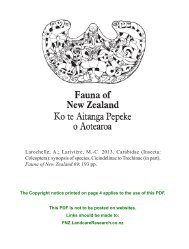Fauna of NZ 45 - Landcare Research
Fauna of NZ 45 - Landcare Research
Fauna of NZ 45 - Landcare Research
Create successful ePaper yourself
Turn your PDF publications into a flip-book with our unique Google optimized e-Paper software.
<strong>Fauna</strong> <strong>of</strong> New Zealand <strong>45</strong> 35<br />
Prothorax longer than wide, strongly constricted at<br />
basal one-third to an unrimmed broad collar, truncate,<br />
without trace <strong>of</strong> an apical constriction, its axial and tangential<br />
convexity pronounced, in pr<strong>of</strong>ile weakly proclinate, only<br />
1.4x longer dorsally than ventrally; notum lacking<br />
impressions. Scutellum concealed.<br />
Elytra broadly elliptical, inflated, lacking humeral callus,<br />
jointly rounded to a rather narrow apex, vertical at base, in<br />
pr<strong>of</strong>ile highly humped, strongly, uniformly convex. Striae<br />
totally erased on upper surface, but striae conspicuous on<br />
underside, here showing nearly as wide as interstriae, also<br />
stria 10 visible at posterior end; vestiture highly caducous,<br />
whence usually not present anymore; inferolateral flange<br />
continued as a fine line a little beyond the locking groove.<br />
No hind wings, not even stumps present.<br />
Mesepimeral suture obsolete, not sulcate but<br />
occasionally with a slight impression against elytra; mesoand<br />
metasternal processes not meeting between coxae;<br />
metasternum short, hind margin in front <strong>of</strong> coxae distinctly<br />
concavely curved. Process <strong>of</strong> ventrite 1 broadly rounded;<br />
suture 1 <strong>of</strong> abdomen laterally distinct; ventrite 5 in male<br />
subtruncate, shallowly bisinuous, not rimmed at apex, in<br />
female rounded. Tergite 1–6 totally depigmented; membrane<br />
between tergites 7 and 8 lacking pouch in both sexes.<br />
Fore coxae long, slender, slightly antemedian owing to<br />
prothorax being ventrally rather long, a little less long in<br />
front than behind coxae. Trochanters elongate, all on lower<br />
edge longer than wide. Femora weakly swollen, hind ones<br />
well short <strong>of</strong> reaching apex <strong>of</strong> elytra. Tibiae lacking mucro<br />
in both sexes.Tarsi lineal, tarsite 2 weakly broadened apicad,<br />
tarsite 3 with long, slender lobes; claw segment passing<br />
tarsite 3 by half the length <strong>of</strong> this tarsite; claws divaricate,<br />
slender, simple, without a tooth or lamina, Fig. 114.<br />
Male. Tergite 8 as in Fig. 112–113, strongly rounded at<br />
apex, a good deal visible ventrally beyond abdomen, lacking<br />
carinae or flanges. Sternite 8 as in Fig. 115, with deep<br />
emargination. Sternite 9 as in Fig. 115–116, with somewhat<br />
symmetrical arms, these not or hardly shorter than apodeme,<br />
with a heavily pigmented transverse sclerite articulating<br />
with the tips <strong>of</strong> arms. Tegmen as in Fig. 117–118, as long<br />
as aedeagus, distinctly articulated on sides, unusually robust<br />
as a whole below articulation; the dorsal sector short,<br />
strongly pigmented laterally and apically, entire at apex,<br />
with a very short membrane at apex and a pair <strong>of</strong> short<br />
setae, central area uniformly, weakly pigmented, bilobed<br />
cephalad. Aedeagus (Fig. 119–120) very long, extending<br />
deeply into the thoracic lumen; pedon parallel-sided, weakly<br />
pigmented, ending in a long, subuliform apex; tectum and<br />
tectal arms weakly pigmented; apodeme slightly longer<br />
than main body, tightly articulating with pedon, internal<br />
sac extending to a little beyond middle <strong>of</strong> apodemes, lacking<br />
sclerites but with fine wall lining.<br />
Female. Colleterial gland at base <strong>of</strong> common oviduct<br />
absent. Bursa and spermatheca as in Fig. 121; one very<br />
large egg present at any one time, a mature egg measuring<br />
0.875 x 0.50 mm in a 1.4 mm long female, the egg extending<br />
into the thoracic cavity.<br />
Distribution. New Zealand, endemic.<br />
Host plant. Unknown.<br />
Remarks. One species, usually obtained from sifted bush<br />
floor litter. In habitus not unlike the flightless Apotapion<br />
Zimmerman (1943) <strong>of</strong> Fiji and Vanuatu and, apparently,<br />
nearest to this genus in affinity for sharing similarly gibbous<br />
prothorax and elytra, a rather long prosternum in<br />
front <strong>of</strong> coxae, a subcompact antennal club, lack <strong>of</strong> an<br />
apical constriction <strong>of</strong> prothorax, a concealed scutellum, no<br />
humeral callus, no mucro on any tibia in both sexes, and<br />
simple claws. Apotapion differs, however, considerably in<br />
having a short antennal scape, broad tarsi, a shorter first<br />
antennal club segment, an intersegmental sclerite near the<br />
emargination <strong>of</strong> sternite 8, a distinct sclerite in the internal<br />
sac, no bladal sclerite on sternite 9 <strong>of</strong> male, and normal<br />
eyes without any glaze over ommatidia. One <strong>of</strong> the dissected<br />
females had an egg (Fig. 157) that filled up virtually<br />
the entire abdomen and good part <strong>of</strong> the mesothoracic lumen.<br />
It is not uncommon that very small beetles have very<br />
large eggs in relation to their size, for instance Ptiliidae<br />
(Dybas 1966) and Limnichidae (Britton 1977).<br />
Etymology. Zelápterus is derived from ‘zel’, short for the<br />
Latin name <strong>of</strong> New Zealand (Nova Zelandia), and ápterus<br />
for the lack <strong>of</strong> hind wings; gender masculine.<br />
Zelapterus terricola (Broun) n. comb.<br />
Fig. 10, 11, 110–121; Map 12<br />
Broun, 1923: 702 (Apion)<br />
Shiny black, antennae and legs reddish or dark brown.<br />
Vestiture absent except for some hairs on legs and last<br />
ventrite (Fig. 10). Other features are contained in the description<br />
<strong>of</strong> the genus above. Because the original publication<br />
shows accurate and detailed observations by Broun,<br />
his description <strong>of</strong> Apion terricola is here reproduced in<br />
full.<br />
Original description. ‘Minute, elongate, very convex,<br />
the elytra especially; glabrous, shining, nigrescent, rostrum,<br />
antennae, and legs piceo-rufous, its punctiform sculpture<br />
obsolete.’<br />
‘Rostrum rather longer than thorax, arched, stout,<br />
cylindrical, slightly narrower in front. Head <strong>of</strong> equal length<br />
and breath, gradually narrowed to almost the same width
















